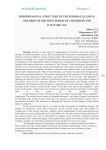Анатомия человека. Рубрика в журнале - Re-health journal

Статья научная
Thymus is the organ of lymphopoiesis of humans and many species of animals, in which maturation occurs. This article presents the results of morphometric studies of red bone marrow in different regions of Kyrgyzstan. The structure (macroscopic picture) of the thymus was studied on 21 corpses of children of the first period, childhood of the second period of adulthood.Used anatomical methods (preparation, measurement) and histological methods (stained with hematoxylin-eosin, according to Van Gieson). Using histological, morphometric methods, it was found that age-related transformations of the tissue structure of the thymus are characterized by the development of fibrous connective and adipose tissue in the cortical septa, which leads to fragmentation of the cortical substance, and then to the separation of fragments of the cortical and brain substance. The greatest progression of the processes of involution in the thymus is noted during the second mature age period from 36 to 60 years.The problems of changing the functions of the immune system during aging are analyzed. Age-related changes in the relative areas of the structural elements of the parenchyma and thymus stroma are established. The thymus consists of lobules, in which there are zones: the inner, lighter brain and the outer darker cortical. Located in the center of the light zones and on their periphery - dark zones. In the darker, cortical zone, the cells are very densely located, their number is much larger than in the center of the medulla zone. In the thickness of the cerebral layer there are single Gassal bodies, blood capillaries, lymph gaps. The cortical layer consists of lymphoid elements, very densely located, with mitoses in individual cells. In the second mature age, iron acquires an inhomogeneous structure due to age-related involution. The problems of changing the functions of the immune system during aging are analyzed. In the second mature age d, in contrast to the first period of childhood thymus, the number of connective tissue fibers decreases. In the second mature age, the number of lymphocytes in the thymus decreases. Adipose tissue predominates in the parenchyma along with connective tissue. During this period, the lobules are reduced to narrow bands and bands. In the second mature age, iron is represented by adipose tissue and thin, randomly scattered parenchyma cords. structural changes in the capsule of the gland; the structure of the cortical and medulla; violation of loose fibrous connective tissue and blood vessels of an organ. The histophysiological characteristic of the thymus was studied, which showed that those living in the city of Kara-Balta, located near the uranium tailing dump, lead to an increase in involutive organ changes due to increased death of thymocytes and a decrease in their proliferative activity.
Бесплатно

